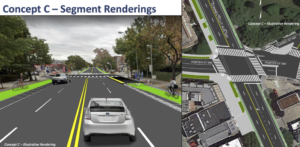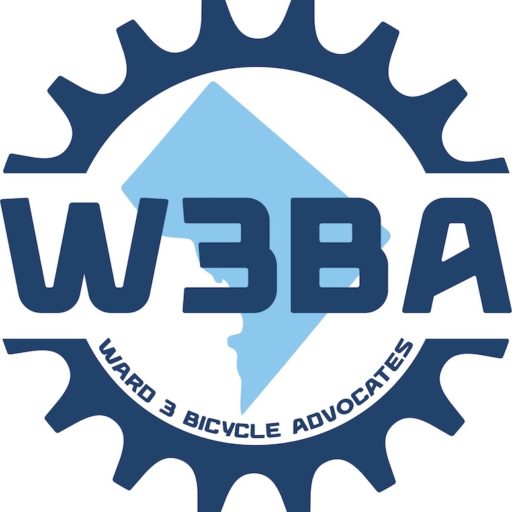
What’s the status of the Connecticut Avenue Redesign?
At the urging of all the ANCs along the corridor and Councilmember Cheh, DDOT launched a study of a redesign of Connecticut Avenue in early 2020. In December 2021, Mayor Bowser announced that the city would proceed with Concept C, which included protected bicycle lanes along with other safety improvements. The redesign is currently planned to stretch from Calvert Street NW to Legation Street NW–a distance of nearly 3 miles, making it one of the longest protected bike lanes in the city. Due to the extensive planning and procurement process, construction is not expected to occur until late 2024 or 2025.
Why hasn’t DDOT gotten feedback from the community?
DDOT has gotten feedback from the community throughout the planning process. All ANCs were represented on the Advisory Committee that assisted DDOT during the process. All the ANCs voted (nearly unanimously) to support the selection of Concept C. DDOT has held numerous community meetings abnd had open comment periods to get feedback from the public, as laid out in the project website.
I don’t ride a bike. What’s in it for me?
The protected bike lanes have gotten most of the attention, but there are benefits for all users of Connecticut Avenue from the redesign. Getting bicyclists off the sidewalk will benefit pedestrians, as will the installation of HAWK signals and refuge islands, the slowing of traffic, and the reduced crossing distances. Installing dedicated turn lanes and traffic calming measures will help people who drive cars do so safely. DDOT is also coordinating with WMTA to improve bus service; this will result in the consolidation of bus stops to speed their travel.
Finally, those who live along Connecticut Avenue will benefit from a more liveable street where there is less traffic, the cars move more slowly, and all users of the street can co-exist.
I’m worried that narrowing Connecticut Avenue during rush hour will push lots of traffic onto neighboring streets.
DDOT conducted a traffic study in 2019, before the pandemic changed traffic patterns in DC. All of DDOT’s traffic projections are based on this data, even though traffic volume is still much less than it was at that point in time.
DDOT’s analysis concluded that around 7,000 vehicles per day would use alternative roads. Half would use local alternatives, such as Massachusetts, Wisconsin, Reno, while half would use other options such as 16th Street. DDOT concluded that the capacity of those roads was sufficient to handle the increased volume of cars.
DDOT’s analysis also concluded that the length of time it would take to drive the entire length of the corridor would increase by just 7 or 8 minutes for through traffic.
No one bikes on Connecticut Avenue…why are we installing bike lanes there that will benefit just a few? Couldn’t they go on another street?
Few people bike on Connecticut Avenue–or in Ward 3 generally–because we have not built roads where people feel safe riding a bicycle. We need to redesign not just Connecticut Avenue but all of our streets so that people of all ages and abilities feel safe biking. On busier roads, this means giving bicycles a space that is physically separated from cars.
A bicycle lane on Connecticut Avenue makes sense for the same reason that people want to drive on Connecticut. It is a direct route that connects our neighborhoods and commercial centers, and will serve as a backbone of a larger bicycle network throughout this part of the city. The large number of schools on and near Connecticut Avenue make it a logical way for kids to bike to school. DDOT’s analysis of biking on Connecticut Avenue concluded that it would be one of the most heavily used bike lanes in the city.
Finally, making it easier and safer for people to bike is essential if Washington DC is to meet its goals related to fighting climate change.
I’m worried that the loss of parking will hurt small businesses.
In response to community feedback, DDOT’s plans preserve parking on one side of the street in commercial areas. Additionally, most of the commercial areas contain significant parking just off of Connecticut Avenue. For example, there are multiple garages in the Van Ness neighborhood. And a survey of parking in the Chevy Chase retail area found that there are just 49 parking spots on Connecticut Avenue but 37 on the side streets and 364 spaces in the parking lots just off Connecticut Avenue. Clearly there is enough parking; it just needs to be used more effectively. Finally, DDOT is working closely with the local retailers and ANCs to determine the best locations for loading zones and pick-up / drop-off zones.
Numerous studies have examined the effect of bike lanes on local businesses. These studies have generally found that adding bike lanes has no effect on businesses or a positive effect, even when parking is lost. A more detailed analysis is here.
What happens next?
DDOT will study the potential extension of the lanes north from Legation Street to Chevy Chase Circle. This would help make sure that cyclists headed north on the bike lanes weren’t abruptly dumped into fast-moving traffic when they reached Legation Street. It would also provide a connection to Western Avenue, and the neighborhoods on Western. Also, if Connecticut Avenue narrowed from three lanes southbound to two lanes at Legation, it is possible that through traffic might be diverted onto local neighborhood streets in Chevy Chase, DC. For all of these reasons, DDOT should extend the lanes north to Chevy Chase Circle.
Overall, DDOT will continue the design work and is scheduled to share the 60% design plans with the ANC & community either late in 2022 or in early-mid-2023.
Where can I go for more information?
There’s a whole website with more detailed information here. Check it out!
Add your name to those supporting the addition of a protected bike lane on this important corridor.
Please contact the Ward 3 Bicycle Advocates with any questions or to get more involved!
Email: ward3ba@gmail.com
Twitter: @ward3bikes
